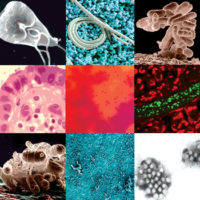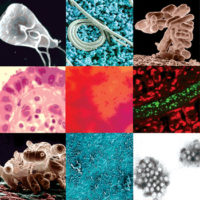With unexpected strains of Salmonella found in peanut butter, the complexities of responding to the microbiological problems faced by the fresh and fresh-cut produce industry, and even the reemergence of Clostridium botulinum and other sporeformers causing problems in carrot juice, canned chilis and stews, crab cakes and olives in 2006 and 2007, the need for enhanced microbiological food safety measures and methods is significant, seemingly widespread—and immediate.
In July, Food Safety Magazine Editorial Director Julie Larson Bricher had the opportunity to speak with several recognized experts from industry, research and government to discuss new challenges in food microbiology. This roundtable-in-print article is based on that discussion, which was co-moderated with Rich St. Clair, Industrial Market Manager for Thermo Fisher Scientific, Remel Products Division, at the International Association for Food Protection annual meeting in Orlando.
Julie Bricher, Food Safety Magazine: With an increasing number of food industry recalls and foodborne illness outbreaks associated with microbial contamination from pathogens and bacterial sporeformers and their toxins, food microbiologists have had a lot to do in the past two years. An unusual strain of Salmonella in peanut butter, the fresh spinach E. coli O157:H7 outbreak, and unexpected adulteration by C. botulinum in both commercial and in-home sources—a toxin that was largely eradicated through proper processing controls in the commercial canned products industry decades ago—have spurred renewed questions about the efficacy of food safety measures and testing methods being used today. How much of a handle do we really have on keeping foods safe, microbiologically speaking? Have the top microorganisms of concern to food supply chain companies changed? How prepared are we to deal with the unexpected or emerging bugs, and how do we calculate the risk factors?
 Mark Carter, Silliker: This is a preface to your general question, Julie, involving the “unexpected” pathogen. First, I think that from a microbial risk assessment standpoint you can’t ever underestimate what “could” happen. There has been data for awhile that says Salmonella survives a very long time in peanut butter, so if you have post-process contamination, it’s not surprising that you’ll find it. It’s not like the organism is going to die off when it has established itself in the product after all of the other interventions have been properly applied. I don’t think you can underestimate what it means to validate processes and controls, or testing methods, for that matter.
Mark Carter, Silliker: This is a preface to your general question, Julie, involving the “unexpected” pathogen. First, I think that from a microbial risk assessment standpoint you can’t ever underestimate what “could” happen. There has been data for awhile that says Salmonella survives a very long time in peanut butter, so if you have post-process contamination, it’s not surprising that you’ll find it. It’s not like the organism is going to die off when it has established itself in the product after all of the other interventions have been properly applied. I don’t think you can underestimate what it means to validate processes and controls, or testing methods, for that matter.
In looking at the literature, we can come across scientific reasons as to why we have found the organisms where we found them. It’s not surprising that we’ve found E. coli in spinach and other produce, for example, because the literature shows that this bug is associated with this type of food. But from a risk assessment standpoint, I think we underestimate where we should even start when identifying the risk factors in the food production chain. That’s a preface to whatever else we say about why the organisms are there in certain foods or what organisms we find. The whole risk assessment portion should drive our decisions about what we should test for and how, and ultimately, where in the process those risk factors exist or are likely to exist.
 Paul Hall, ConAgra Foods: I agree with that, Mark. I think that, as an industry, we are guilty of taking a lot for granted, especially with products that are perceived as low risk foods. “Low risk” is not “no risk,” but a lot of products like peanut butter, chocolate or dry blend products are deemed low risk and that causes confusion for different food safety stakeholders such as consumers, plant managers or other laypeople about the significant difference between the growth of pathogens versus the survival of pathogens. People will say, “Well, it’s not going to support growth, so it’s low risk and therefore I don’t need to worry about it or invest in my infrastructure to maintain the facilities and do the proper cleaning regimens, etc.”
Paul Hall, ConAgra Foods: I agree with that, Mark. I think that, as an industry, we are guilty of taking a lot for granted, especially with products that are perceived as low risk foods. “Low risk” is not “no risk,” but a lot of products like peanut butter, chocolate or dry blend products are deemed low risk and that causes confusion for different food safety stakeholders such as consumers, plant managers or other laypeople about the significant difference between the growth of pathogens versus the survival of pathogens. People will say, “Well, it’s not going to support growth, so it’s low risk and therefore I don’t need to worry about it or invest in my infrastructure to maintain the facilities and do the proper cleaning regimens, etc.”
As far as your question on pathogens of concern, Julie, they are pretty much the same—and have been the same for the last 80 years. Salmonella, the different strains of E. coli (although most are focused on O157:H7) and Campylobacter, but there are other viral and toxigenic strains that pop up now and then. Staphlycoccus aureus and staphlycoccal neurotoxins in certain products is still a concern. C. botulinum in certain products is still a concern.
 Franco Pagotto, Health Canada: With the foodborne pathogens, it’s still your usual top three—Campylobacter, E. coli and its variations, and Salmonella—and these probably won’t go away anytime soon. There is an increase today in looking at foodborne parasites and viruses, in part because the scientific community has built some consensus that these biological contaminants appear to be increasing in importance in foodborne illnesses, as far as known causes go. Studying their impact on foods, their mechanisms and their effect on human health is research that is still in its infancy, and hasn’t been done before, in part because parasites and viruses present unique analytical challenges. For example, they do not grow in foods, you can’t enrich for them and it’s hard to find them when they are there.
Franco Pagotto, Health Canada: With the foodborne pathogens, it’s still your usual top three—Campylobacter, E. coli and its variations, and Salmonella—and these probably won’t go away anytime soon. There is an increase today in looking at foodborne parasites and viruses, in part because the scientific community has built some consensus that these biological contaminants appear to be increasing in importance in foodborne illnesses, as far as known causes go. Studying their impact on foods, their mechanisms and their effect on human health is research that is still in its infancy, and hasn’t been done before, in part because parasites and viruses present unique analytical challenges. For example, they do not grow in foods, you can’t enrich for them and it’s hard to find them when they are there.
 Purnendu Vasavada, University of Wisconsin-River Falls: With regard to the “unexpected” organism line of discussion, I think that, to an extent, we are victims of our own successes. On the one hand, we tell food plant managers that we have all the newfangled devices to help solve microbiological food safety problems. We tell them that we can detect the bugs, that we can do it rapidly and cheaply; in essence, that the bugs can run, but they can’t hide. On the other hand, we forget that we are dealing with the planet’s ultimate opportunistic beings. Microorganisms have been around millions of years and they will be here long after we are gone. If you give them half a chance, they are going to grow and survive, and they are going to proliferate in unexpected states and locations. So, the key is never take microorganisms for granted, never to say, “This is dry product so no self-respecting E. coli would ever touch this product.”
Purnendu Vasavada, University of Wisconsin-River Falls: With regard to the “unexpected” organism line of discussion, I think that, to an extent, we are victims of our own successes. On the one hand, we tell food plant managers that we have all the newfangled devices to help solve microbiological food safety problems. We tell them that we can detect the bugs, that we can do it rapidly and cheaply; in essence, that the bugs can run, but they can’t hide. On the other hand, we forget that we are dealing with the planet’s ultimate opportunistic beings. Microorganisms have been around millions of years and they will be here long after we are gone. If you give them half a chance, they are going to grow and survive, and they are going to proliferate in unexpected states and locations. So, the key is never take microorganisms for granted, never to say, “This is dry product so no self-respecting E. coli would ever touch this product.”
Hall: And there are wider industry trends that also come into play that can allow these organisms to become problematic from a food safety standpoint. We are seeing here in the U.S, a health and wellness trend that is growing where consumers want products that are deemed healthy or natural (fresh or minimally processed), have long shelf lives, and are inexpensive. A good example is the market for and proliferation of products with marketing claims like all-natural or organic, or those made with “heathier” formulations. With many of these products, you can’t use traditional preservatives. For example, sodium reduction lowers salt levels in foods, which means that you’re taking away a traditional preservative (and in some cases, the primary preservative) with no consideration of the synergistic effect of salt with other components of the product formula. So in a way, making an all-natural item to respond to a market trend can and does reduce our ability to control pathogens in the formula if we can’t add salt. With natural or organic products, you are depending on the process itself to help control the pathogens but there are limits as to the processing aids that are allowed. And, although there have been a lot of advancements in novel food preservation and processing technologies that could be used, a lot of them have not been widely adopted by the industry because the costs associated with doing so are still fairly high.
Vasavada: Paul is right, there are obstacles. In order to be proactive, you almost have to do reverse training and education—not from the ground up but from the top down. You’ve got to get management’s buy-in because as long as food safety is considered a cost center companies will not adequately invest in it. I once had a plant manager tell me that “testing never did me any good.” The trouble is if you hire a qualified person to run your lab and give him or her the right budget, you might actually get findings that you don’t like.
 Tom Zierenberg, Microbac Laboratories: I also think the education side is a big concern. Small- to medium-sized manufacturing operations that do have an impact on the public health might not realize it. Everyone takes for granted that the big multinational food companies are investing a lot of money in food safety programs but there are an awful lot of smaller processing operations where the quality assurance (QA) people have struggled to get key company leaders to make the financial decisions to invest in the components of food safety programs, from testing to technology to training. The non-multinationals often don’t have the economic resources, which makes it a tough job for QA personnel to convince company decision makers that food safety must get a piece of the budget pie.
Tom Zierenberg, Microbac Laboratories: I also think the education side is a big concern. Small- to medium-sized manufacturing operations that do have an impact on the public health might not realize it. Everyone takes for granted that the big multinational food companies are investing a lot of money in food safety programs but there are an awful lot of smaller processing operations where the quality assurance (QA) people have struggled to get key company leaders to make the financial decisions to invest in the components of food safety programs, from testing to technology to training. The non-multinationals often don’t have the economic resources, which makes it a tough job for QA personnel to convince company decision makers that food safety must get a piece of the budget pie.
Hall: I absolutely agree. Getting the food safety investment message across to smaller producers is critical. Trade groups like the American Meat Institute have put a lot of effort into educating the smaller businesses about food safety practices and standards, but it is a challenge and will continue to be a challenge when these companies have fewer resources and they may not even know what they need to be looking for, let alone what techniques to use.
And, while the big companies might have a staff of corporate microbiologists at their disposal who can help write HACCP plans and so forth, there are still obstacles to selling food safety investments to management. I tell you, it is like pulling eye teeth to get capital devoted to food safety related improvements like infrastructure, and this goes back to my earlier comments, especially on products that are perceived to be “low risk.” The CEO will say, “Are you kidding me? You want me to put $2 million dollars into fixing this roof when we’ve never had a problem before?” You might bring a lot of data to the table, even examples of other companies making similar products who have had recalls of similar “low risk” products or information on how changes in processes may increase the risk of a type of contamination, and still meet with the “it’s never going to be us” mentality. And it’s a foolish and dangerous attitude because what happens is you get into these mega-recalls that we have been having recently.
 Beth Ann Crozier-Dodson, Kansas State University: Some of the smaller or mid-sized companies don’t understand why they are doing testing in the first place. For example, one company called our lab and said they had a problem with mold in their private label processing facility. We assessed the plant and showed them where the mold was entering, explained why it was entering and what they should do to prevent it. We suggested that they hire a staff microbiologist or a trained food safety professional since they were manufacturing and labeling products for other companies. They replied that it was too expensive. They continued to call us about ongoing mold problems, we continued to ask whether they were shutting the receiving door, etc., and they continued to say well no, they weren’t really following our recommendations.
Beth Ann Crozier-Dodson, Kansas State University: Some of the smaller or mid-sized companies don’t understand why they are doing testing in the first place. For example, one company called our lab and said they had a problem with mold in their private label processing facility. We assessed the plant and showed them where the mold was entering, explained why it was entering and what they should do to prevent it. We suggested that they hire a staff microbiologist or a trained food safety professional since they were manufacturing and labeling products for other companies. They replied that it was too expensive. They continued to call us about ongoing mold problems, we continued to ask whether they were shutting the receiving door, etc., and they continued to say well no, they weren’t really following our recommendations.
Later, when that company was involved in a recall that cost about a quarter of a million dollars due to mold contamination of their products, I wondered what their cost/benefit analysis looked like? Did it really take an economic hit of this magnitude for the company to realize that a qualified microbiologist on staff would have been a good investment?
 Roy Betts, Campden & Chorleywood Food Research Association: Yes, one big challenge is the emerging pressure from either governments or consumers to change the foods that we eat—to make them healthier, lower in salt, lower in fat. We’re seeing in the UK and in the U.S. that the next food-related issue is going to be obesity, which means that food manufacturers will be taking down sugar, salt and fat levels in their products. The issue is that when we do that we are changing the composition of and the key preservation parameters for foods that we have a long history of producing and therefore a good understanding of what the microbial risks are and how to control them, both from a product composition standpoint and a processing or production standpoint. Now we’ve reformulated the product to achieve a “healthier” version, but do we now have the experience to understand the microbiological implications?
Roy Betts, Campden & Chorleywood Food Research Association: Yes, one big challenge is the emerging pressure from either governments or consumers to change the foods that we eat—to make them healthier, lower in salt, lower in fat. We’re seeing in the UK and in the U.S. that the next food-related issue is going to be obesity, which means that food manufacturers will be taking down sugar, salt and fat levels in their products. The issue is that when we do that we are changing the composition of and the key preservation parameters for foods that we have a long history of producing and therefore a good understanding of what the microbial risks are and how to control them, both from a product composition standpoint and a processing or production standpoint. Now we’ve reformulated the product to achieve a “healthier” version, but do we now have the experience to understand the microbiological implications?
To complicate matters, the discipline of food microbiology is losing experience. The most experienced food microbiologists are at retirement age, and their real-world experience is not being replaced. So then we don’t have the historical knowledge base in product development to understand that when we take the level of salt down and we put a fat replacement in, we change the microbiology. That change can allow organisms to grow in the product that didn’t before, and then we have a food safety problem and we wonder why.
Larson Bricher: This is definitely a concern that I’ve heard from food company microbiologists who feel that there is a critical need for better communication with both the product developers and the marketing departments in their organizations. These microbiologists feel an obligation to make sure that product developers include common sense—even as they are thinking outside the box in creating the trendy, tasty new products or reformulating existing recipes that meet the marketers’ requirements. In other words, microbiologists want them to ask, what are the consequences of the changes I make? My new product now has an extended shelf life and really tastes good, but are these gains at the expense of the safety of the product? Have I considered whether the finished product or process by which it is made is conducive to microbial growth, and if so, why and what can be done to mitigate it while retaining the quality attributes? Ultimately, is this product going to make someone sick?
So, this idea that it is important that we somehow pull together the quality chemistry and the food safety microbiology to ensure there aren’t going to be any adverse synergistic effects seems dependent on good communication between these departments. It might also increase accountability for food safety among marketing decision makers and R&D who do share in the responsibility to make sure that any product that makes it to the retail shelf is safe.
Betts: You can often get enquiries from food producers asking what shelf life they should assign to a new product that they intend to launch within a couple of weeks. Of course that is a question that should be asked early on in product development. If microbiological shelf life testing is required to obtain this information, this has to be done over the whole life of the product, which could span several weeks to months. You just can’t give that sort of information, that quickly.
Vasavada: Roy is absolutely right. There are tremendous pressures in the industry and the product-to-market cycles have been squeezed from 18 months to two weeks. One of my good friends in Minneapolis says, “I can take any microbiologist and teach him marketing in two weeks, but other way around, give me a lifetime, I can’t do that.” But it really is about education and communication. I have had local farmers tell us, “I produce organic food. My product doesn’t have Salmonella.” And I have to tell them, “No, ma’am, you just have organic Salmonella.” No matter where you are in the food supply chain, it is important to understand your product and processes to ensure food safety, no matter the marketing claim. It is up to scientists to communicate these concepts.
Hall: Larry Keener of International Product Safety Consultants presents an outstanding seminar on getting return on investment for food safety, in which he shows that if you do food safety right, it will enable you to market novel and profitable products—and oh, by the way, keep you out of trouble while doing it. But as scientists, we’re not generally trained to talk marketing or business lingo. Our passion is science and food safety. As P.C., is saying, we’ve got to learn how to articulate these science-based concepts to non-scientists. I had a boss once who said that his job was to take “R&D-ese” and translate it into “MBA-ese,” recognizing that the scientific technical community definitely speaks a different language than the business guys. So, food scientists need to learn how to sell upper management the food safety proposition, meaning we have to package scientific concepts and show them that, hey if we do it this way, we’re going to keep you out of trouble, and you’re going to be able to get you products to market faster, be able to innovate to meet market demand, and so on.
Vasavada: If that doesn’t work, asking them if they look good in orange might get their attention.
Zierenberg: Like Paul is saying, I think scientists as a collective group are ambassadors of food safety. Educating those stakeholders who are involved outside of the scientific world can be a struggle but it helps further the cause. Sometimes it’s easy for marketing people or people running companies to jump to conclusions based on one small test or scientific measurement, and the misunderstanding of what the science is really telling them or the misinterpretation of the initial data causes problems. An example of this is when a company decides to scale-up production of a product based on the results of one shelf-life challenge study, but the increased volume of production actually changes the parameters such that there might exist a microbiological or other hazard in the production line that wasn’t there before.
Crozier-Dodson: Well, I agree with that, too. A lack of scientific understanding on the part of the food processor, about why they are testing or even what they should be testing for, can be a real problem. There was a new sampling method that was introduced several years ago that drove this home for me. The processors I talked to who were using it were ecstatic because their detectable E. coli counts went to zero. But it was surprising to me that if you changed nothing but your sampling or testing method, and your numbers went from whatever you were getting before to zero, that it didn’t cross the processors’ minds to question the veracity of the testing method itself to verify that it worked. Now, you have no idea what you’re sending out there and instead of being happy, you should all be sobbing softly in a corner.
Betts: It does happen, I can remember cases of laboratories using inferior methods for Listeria detection in ingredients The ingredients were supplied to another manufacturer who found Listeria in the ingredient. It was devastating for the ingredient supplier involved because they believed they were running a really good food safety program and had Listeria under control, when in reality they had no idea what was really going on in production. That’s where good methods that give correct reliable results come back into it. So, yes, the decision makers need to have the right information from which to make food safety decisions, which means we have to have the right test methods.
Larson Bricher: So, are we able to be proactive about microbiological food safety, or are we still strictly reactive? Can we ever get to a point in micro testing where we can truly be proactive?
Carter: There are challenges there. Companies still primarily test for what is legislated—the same group of organisms. In 100 years, will we still have problems with Salmonella, Campylobacter and E. coli; will we still do the same tests over and over again? At some point, there has to be opportunities to use other methods or other techniques that will help us understand the situation better. There has to be some room for innovation in order to be proactive, but again, industry and legislative bodies have to accept that innovation, wherever it is applied.
The majority of the industry cannot afford to do custom polymerase chain reaction (PCR) testing like a government research center can. There has got to be methods available that are accurate, validated, usable and easy to use, and that can be used at different levels. If you’re doing a risk assessment, for example, tools like quantitative PCR could be beneficial to understand the levels of organisms that are in a product. But we still need good enrichments because we haven’t yet worked out how to extract organisms from a number of food matrices. The end-point detection systems are improving but I still harp on the fact that I don’t think we do a tremendous job of doing validations on all types of tests. And we are facing more difficult organisms like viruses and
parasites. But we appear to be stuck on specific groups of organisms and the techniques we used to detect and identify these really haven’t changed.
Betts: And again, there are food companies that do not understand, even in this limited group of legislated organisms, what they are testing for or why they are testing for it. Somewhere in the dictionary there must be a definition for “full micro” because we get phone calls from companies that say they want testing, and when we ask what they want tested, they say, “full micro.”
Carter: We only know something is a problem because we can find it. Clinicians are not going to find it from a food, they are going to find it from a human being. So we’re working backwards until there is an illness—and this is just dealing with pathogens. I think all of us here know that we don’t know what organisms cause illness in the great majority of people who get sick. How do you address the fact that we get in the mindset that we only test for what we know is an issue? And how does that fit into the idea of being proactive? Because it seems to me that the only thing to do is to be reactive because you are only testing for what you already know is a problem. That’s really the connundrum.
Betts: I believe we can be proactive with the technology we have now. There are technologies available now that allow you to test for microbiological and even chemical contaminants at the same time. There is a push towards detecting live versus dead cells, as well. My concern is, what are we going to do when we don’t have to isolate an organism anymore? From a diagnostic point of view, you can get a rapid answer fairly quickly and I think that’s good. But from a science point of view, it’s also scary that if you don’t have to isolate an viable organism, you can’t study its evolution, its physiology, biochemistry or survival characteristics anymore either. These are the things that allow us to understand the risks associated with bacteria in foods, and we do need to know them. At the moment none of the commercially available rapid methods can give you a molecular pattern or fingerprint for an organism to allow you to do proactive real-time epidemiology unless you isolate an organism and then do some molecular type of technique. It is detection only.
Larson Bricher: So how can you harness microbiological methods and technologies to help you turn from a cost center into a real benefit within your own business segment?
Hall: Well, I’ll give you an example. There are some great tools out there in the field of rapid microbiology methods. The obvious savings for a lot of these methods is time savings. So where time is important, time to result is important. Using Listeria as an example, we have a variety of technologies that help us enumerate, detect and identify this pathogen. We use Listeria species as an indicator organism for environmental monitoring and we can use riboprinting or pulsed field gel electrophoresis to actually make genetic maps of resident organisms in a food processing plant. This blueprint enables us watch how these bugs get transferred around the plant and you can differentiate your “house” bugs from the transient bugs, which is valuable in helping you do your detective work and focusing in on your sanitation and maintenance programs. This is a good example of the type of powerful tools we do have at our disposal that can be used to help allocate resources and set priorities in the plant to increase food safety.
Betts: And we’ve got very good genomics tools now. Traditionally, microbiologists would take an E. coli, put it on a food and study it to see if they could recover it. We’ve got tools today that actually are able to show why is it a certain type of E. coli or a certain type of Salmonella is causing the problem. Those are emerging as very useful tools as they allow us to understand the mechanisms by which certain bacteria become a problem.
Pagotto: As a government scientist, my goal is to keep Canadians and other people safe. When I hear people say it is about money or marketing, it goes over my head. The scientist part of me does not get surprised when we find C. botulinum in carrot juice—pathogens are not going to go away. Mark is talking about using microbiology methods to do the epidemiological work so we can know more about what the pathogen is doing and at the same time, what and how the host is responding. I think we can combine some of these technologies to find out why, for example, a group of children in a daycare get campylobacteriosis, but only one child will get Guillain-Barré later on.
Crozier-Dodson: And, we’ve got to be proactive with the application of methods as they exist now. Conventional methods are extremely important to food microbiologists and they are not going away just because we now have rapid or automated methods. We need to make sure that young microbiologists are educated about how to do conventional techniques, when to apply them and why. At the same time we need to be careful about educating people about using rapid methods, which are designed to be so easy to use that non-scientists can use them. The problem is that plant personnel might use the right rapid method but use it incorecctly, or vice versa, and then the results are skewed.
Larson Bricher: Okay, I’d like to do the rapidfire round: What’s on your food microbiology wish list?
Hall: We haven’t talked much about sampling plans today but I would like to see more tools up front in the testing program, meaning better sample preparation, concentration and capture technologies that can be used in combination with rapid microbiological detection and identification methods.
Betts: I think there has to be a merger of the old and the new. The chromogenic media are very good, for example, particularly when you know you want to detect and differentiate between L. innocua and L. monocytogenes. At the same time, you likely still need to do biochemical testing or PCR to verify those results. Whatever the best method is, that’s what we should be using, and we shouldn’t be scared to mix method types to get the best results.
Crozier-Dodson: I’d like to see better air sampling methods and technologies, as well as better methods to estimate injured cell populations, which are often underestimated in the research. Also, I would like to see more focus on education and training for those people who deal with food safety and testing, in the areas of both conventional and rapid method technologies for improved understanding of food microbiology.
Zierenberg: I’d like to see more commitment to risk assessment and the development of improved predictive microbiology strategies. I think companies need to have tools so they can be more proactive in looking forward to identify and control risk factors in their operations before finding themselves in adverse situations trying to catch up. So my wish list would include enhanced industry education and understanding of what true food safety risks lay ahead. Part of this risk lies in the fact that in many situations, some food companies make food safety decisions that are not made by scientists but rather by lesser skilled technicians. Often these individuals are brought into the quality control department, without possessing the knowledge or understanding of food science to help them make these important decisions. I think some of the expertise that a seasoned food microbiologist can provide may get left out of the equation.
Carter:<
Food Microbiology in Focus: An Expert Roundtable




